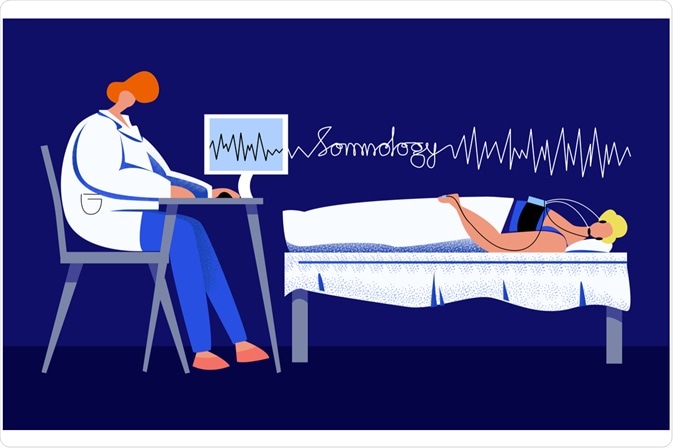Polysomnography is a non-invasive and painless test performed while the individual is asleep to allow the sleep patterns to be observed and monitored. It is usually recommended when an individual reports symptoms of difficulty sleeping or it is suspected that they may have a sleeping disorder.
The test involves sleeping in a controlled environment to monitor various factors that can be indicative of certain sleep disorders or conditions.

Image Credit: Viktoria Sokolova / Shutterstock.com
Purpose
Polysomnography is used to observe and monitor the sleep stages to identify the sleep patterns of an individual and possible factors that may affect this. The test is useful to investigate symptoms that may be indicative of sleep disorders, such as:
- Sleep apnea
- Periodic limb movement disorder
- Narcolepsy
- Rapid eye movement (REM) sleep behavior disorder
- Chronic insomnia
Polysomnography is often used to monitor sleep patterns in individuals with unusual sleep behaviors or difficulty falling or staying asleep, which can have an impact on their quality of life.
Polysomnography at Tri-C
Preparation for polysomnography
Before a polysomnography, individuals may be advised to avoid the consumption of certain substances that may affect sleeping patterns, such as alcohol and caffeine. This is usually recommended for the afternoon and evening of the polysomnography. Napping in the afternoon should also be evaded.
It is important that individuals are comfortable in the sleeping environment. Many people find it beneficial to bring their own pajamas and other items that they usually use during their nighttime routine.
Polysomnography procedure
Individuals usually arrive at the sleep center in the evening to stay overnight for their sleep patterns to be monitored.
The environment is typically set up in a similar style to a hotel room, with a private bathroom and little noise or light to distract the individual. The room is equipped with a video camera to capture the movement and behavior of the individual as they sleep, as well as an audio system to allow any sounds to be monitored. This also permits communication between the patients and the technicians, if needed, such as if the patient needs to go to the bathroom in the night.
After the individual has finished getting ready for bed according to their nightly routine, a sensor will be placed on their scalp, temples, chest, and legs. The sensors are connected to the computing system, via long wires that allow the individual to move freely in the bed. A monitor for the patient's blood oxygen level is also placed on the finger or ear of the patient to record any changes.
It is normal to have more difficulty falling asleep than usual in the unfamiliar environment; however, this will not affect the results, as each of the sleep stages will eventually be reached, even if the time to get to sleep is longer.
Depending on the purpose of the polysomnography, there may be other specific machines involved in the study. For example, a positive airway pressure (PAP) machine can help to enhance breathing for individuals with sleep apnea.
In the morning, the sensors are removed and the individual can leave the sleep center and continue with normal daily activities immediately.
Results
During the polysomnography, a system monitors several different factors that are involved in the sleeping patterns, including:
- Brain waves
- Eye movement
- Heart rate
- Breathing rate
- Blood oxygen level
- Positioning of body
- Movement of limbs
- Sounds made while sleeping
Each of these factors are recorded on a graph and create a cohesive picture of the overall sleep stages and quality. The information from the study can help to identify any problems in the sleep or sleep disorders that may be evident.
The data will initially be collated and used to create a graph by a polysomnography technician and the final results from the general practitioner to the patient may take up to two weeks to become available.
References
Further Reading